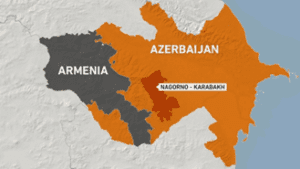TAG: GS 2: INTERNATIONAL RELATIONS
THE CONTEXT: Armenia is experiencing a wave of protests demanding the resignation of Prime Minister.
EXPLANATION:
- The demonstrations, sparked by the government’s controversial decision to return four border villages to Azerbaijan, have expanded to encompass broader discontent with Pashinyan’s administration.
- The situation is further complicated by recent flooding in the Tavush region, exacerbating public dissatisfaction and adding urgency to the protesters’ demands.
Background of the Protests
- The immediate cause of the protests is the Armenian government’s decision to return four border villages in the Tavush region to Azerbaijan.
- This decision followed a rapid military campaign by Azerbaijan in September, which forced ethnic Armenian separatists in the Karabakh region to surrender.
- The capitulation resulted in Azerbaijan regaining full control of Karabakh, prompting the exodus of approximately 120,000 ethnic Armenians from the region.
Historical Context
- The conflict over Karabakh has deep historical roots.
- Ethnic Armenian fighters, with the backing of the Armenian military, took control of the region in 1994 after a protracted six-year war.
- Azerbaijan regained some of the territory after renewed fighting in 2020, which ended with a fragile armistice enforced by a Russian peacekeeping force.
- The recent withdrawal of this peacekeeping contingent has heightened tensions and instability in the region.
- While the return of the villages was the initial catalyst, the protests have grown to reflect a wider array of grievances against Pashinyan’s administration.
- These include accusations of mishandling the conflict with Azerbaijan, failing to secure Armenian territorial integrity, and broader issues of governance and public trust.

Government Response and Public Safety Concerns
- In response to the protests, police have detained 196 people in Yerevan alone.
- Demonstrators have blocked main streets in the capital and other parts of the country, leading to sporadic clashes with law enforcement.
- The heavy-handed police response has further fueled public anger and intensified the protests.
- Prime Minister has defended his actions, arguing that defining the border with Azerbaijan is essential to prevent further hostilities.
- He has emphasized the need for stability and peace, though his assurances have done little to quell the rising tide of public dissatisfaction.
Impact of Recent Flooding
- The protests have been further inflamed by severe flooding that has hit the Tavush region and adjacent areas.
- Armenian officials reported that at least four people have died and 429 others have been evacuated.
- The flooding has isolated several settlements, complicating rescue efforts and highlighting infrastructural vulnerabilities.
- The Armenian national rescue service has been working to address the crisis.
- Efforts include constructing a cableway to reach some of the stranded areas, but the disaster has underscored the government’s perceived inability to manage crises effectively, adding another layer of criticism against Pashinyan’s administration.
Broader Implications
- The ongoing protests and political instability in Armenia have significant implications for regional stability.
- The unresolved conflict with Azerbaijan, coupled with internal discontent, could lead to further violence and instability in the South Caucasus region.
- Internationally, the situation in Armenia is being closely watched.
- The protests highlight the complex interplay between domestic politics and international relations, particularly in the context of Armenian-Azerbaijani tensions and the influence of external actors such as Russia.

